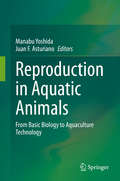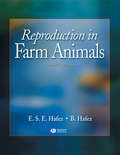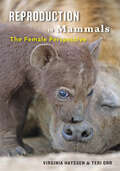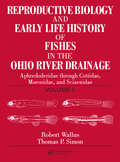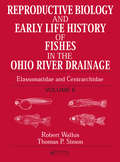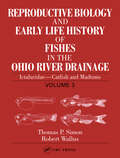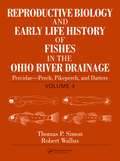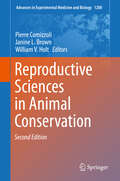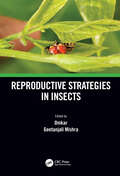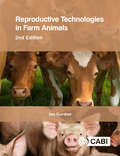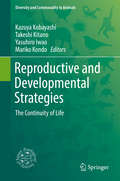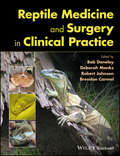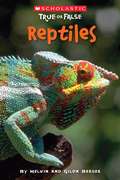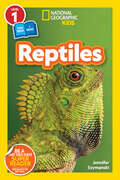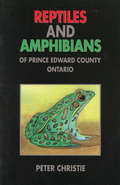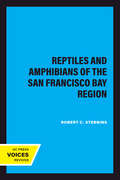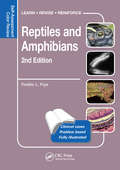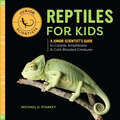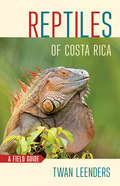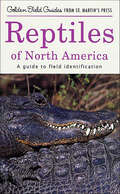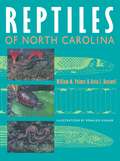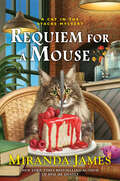- Table View
- List View
Reproduction in Aquatic Animals: From Basic Biology to Aquaculture Technology
by Manabu Yoshida Juan F. AsturianoThis book provides an up-to-date overview of the various reproductive systems of a variety of aquatic animals, from invertebrates to fishes. While all terrestrial animals use internal fertilization, aquatic animals have diverse reproductive systems. Some are internal fertilizers with or without mating, but many perform external fertilization. Because of this diversity, the reproductive systems of aquatic animals represent excellent models for the study of adaptive evolution and the species specificity of fertilization. In addition, many aquatic animals, including fish, crustaceans, and mollusks, are important as fishery and aquaculture resources. In this book, up-and-coming researchers examine reproductive systems in representative aquatic animals, covering both the basic knowledge and late-breaking results. Reproduction in Aquatic Animals: From Basic Biology to Aquaculture Technology will be of interest to graduate and postgraduate students in biology and agricultural sciences, as well as to researchers and technicians in the fields of reproductive biology and fishery science and to non-academics.
Reproduction in Farm Animals
by B. Hafez E.S.E. HafezWhen you’re looking for a comprehensive and reliable text on large animal reproduction, look no further! the seventh edition of this classic text is geared for the undergraduate student in Agricultural Sciences and Veterinary Medicine. In response to reader feedback, Dr. Hafez has streamlined and edited the entire text to remove all repetitious and nonessential material. That means you'll learn more in fewer pages. Plus the seventh editing is filled with features that help you grasp the concepts of reproduction in farm animals so you'll perform better on exams and in practice: condensed and simplified tables, so they're easier to consult an easy-to-scan glossary at the end of the book an expanded appendix, which includes graphic illustrations of assisted reproduction technology Plus, you'll find valuable NEW COVERAGE on all these topics: Equine Reproduction: expanded information reflecting today's knowledge Llamas (NEW CHAPTER) Micromanipulation of Gametes and In Vitro Fertilization (NEW CHAPTER!) Reach for the text that's revised with the undergraduate in mind: the seventh edition of Hafez's Reproduction in Farm Animals.
Reproduction in Mammals: The Female Perspective
by Virginia Hayssen Teri J. OrrA fascinating look at the diverse reproductive strategies of numerous female mammals, from hyenas to goats, kangaroos to whales.Newborn mammals can weigh as little as a dime or as much as a motorcycle. Some receive milk for only a few days, whereas others nurse for years. Humans typically have only one baby at a time following nine months of pregnancy, but other mammals have twenty or more young after only a few weeks in utero. What causes this incredible reproductive diversity? In Reproduction in Mammals, Virginia Hayssen and Teri J. Orr present readers with a fascinating examination of the varied reproductive strategies of a broad spectrum of mammals, from marsupials to whales. This unique book's comprehensive coverage gathers stories from many taxa into a single, cohesive perspective that centers on the reproductive lives of females. The authors shed light on a number of intriguing questions, including• do bigger moms have bigger babies?• do primates have longer pregnancies than other groups?• does habitat influence animals' reproductive patterns?• do carnivores typically produce larger litters than prey species?The book opens with the authors' definition of what constitutes a female perspective and an examination of the evolution of reproduction in mammals. It then outlines the typical individual mammalian female: her genetics, anatomy, and physiology. Taking a nuanced approach, Hayssen and Orr describe the female reproductive cycle and explore female mammals' interactions with males and offspring. Readers will come away from this thought-provoking book with an understanding of not only how reproduction fits into the lives of female mammals but also how biology has affected the enormously diverse reproductive patterns of the phenotypes we observe today.
Reproductive Biology and Early Life History of Fishes in the Ohio River Drainage: Aphredoderidae through Cottidae, Moronidae, and Sciaenidae, Volume 5
by Robert Wallus Thomas P. SimonThis seven-volume series is the most extensive treatise on early life histories of the freshwater fishes of North America. It represents the state-of-the-art in fishery biology and provides a systematic approach to the study of early life histories of all the fishes in this region. Each volume contains distinguishing characteristics and a pictorial
Reproductive Biology and Early Life History of Fishes in the Ohio River Drainage: Elassomatidae and Centrarchidae, Volume 6
by Thomas P. Simon Robert WallusThis seven-volume series is the most extensive treatise on early life histories of the freshwater fishes of North America. It represents the state-of-the-art in fishery biology and provides a systematic approach to the study of early life histories of all the fishes in this region. Each volume contains distinguishing characteristics and a pictorial
Reproductive Biology and Early Life History of Fishes in the Ohio River Drainage: Ictaluridae - Catfish and Madtoms, Volume 3
by Thomas P. Simon Robert WallusThis series fills immense gaps in knowledge of issues related to early life development of fishes in the Ohio basin. Volume III addresses the developmental and morphological issues of catfish and madtoms. This volume describes the characteristics of the Ictaluridae family, and provides a detailed pictorial guide. Subtopics within each species description includes range, distribution, occurrence, spawning, eggs, development, ecology of early life phases, and more. This book serves as both a guide to help identify individual larval fish and as a reference for environmental managers concerned with the overall health of the ecosystem that they are monitoring.
Reproductive Biology and Early Life History of Fishes in the Ohio River Drainage: Percidae - Perch, Pikeperch, and Darters, Volume 4
by Thomas P. Simon Robert WallusKnowledge of the early life stages of fishes is crucial for the effective monitoring and management of fish populations and habitats, and the evaluation of environmental impacts and recovery of endangered species. Unfortunately, the proper identification of targeted species has stunted the development of the field. Now a series has emerged
Reproductive Sciences in Animal Conservation: Progress And Prospects (Advances in Experimental Medicine and Biology #1200)
by William V. Holt Janine L. Brown Pierre ComizzoliThis second edition emphasizes the environmental impact on reproduction, with updated chapters throughout as well as complete new chapters on species such as sharks and rays. This is a wide-ranging book that will be of relevance to anyone involved in species conservation, and provides critical perspectives on the real utility of current and emerging reproductive sciences.Understanding reproductive biology is centrally important to the way many of the world’s conservation problems should be tackled. Currently the extinction problem is huge, with up to 30% of the world’s fauna being expected to disappear in the next 50 years. Nevertheless, it has been estimated that the global population of animals in zoos encompasses 12,000 – 15,000 species, and we anticipate that every effort will be made to preserve these species for as long as possible, minimizing inbreeding effects and providing the best welfare standards available. Even if the reproductive biology community cannot solve the global biodiversity crisis for all wild species, we should do our best to maintain important captive populations. Reproductive biology in this context is much more than the development of techniques for helping with too little or too much breeding. While some of the relevant techniques are useful for individual species that society might target for a variety of reasons, whether nationalistic, cultural or practical, technical developments have to be backed up by thorough biological understanding of the background behind the problems.
Reproductive Strategies in Insects
by OmkarReproduction is one of the most inherent tasks that all living organisms are actively involved in. It forms the backbone of their existence with all evolutionary energies directed over billion years of creation into maximizing reproductive effort. For so simple and directed a need such as maximizing reproduction, it is interesting to see how much diversity and complexity exists in this task. Each organism despite having the same end goal employs different strategies. The complexities, intricacies and strategies of successful reproduction while being extremely fascinating are equally befuddling. Reproductive Strategies in Insects provides an expansive critical look at the reproductive strategies of the most diverse group of animals, the insects. Insects which inhabit myriad niches in all ecosystems except the oceans, show the most diverse reproductive strategies ranging from simplest to most complex. Reproductive strategies, viz., search for mates, number of mates, display of mate quality, assessment of mate quality, acceptance of mate, rejection of mates, forced copulations, the fight for paternity pre, during and post copula, the modulation of paternity, ovipositional strategies and parental care are described in detail in this book. Also, each strategy in analyzed in relation to its morphological, physiological, ethological, ecological and evolutionary aspects. Features: Covers a wide variety of reproductive strategies, A detailed step by step description of reproductive strategies. Discusses morphological, physiological, ethological, ecological and evolutionary aspects. Modulation of these strategies and responsible modulatory factors are also discussed. Well-illustrated. Recent research results and probable future research directions. This is a niche reference book for ethologists, biologists studying behavioural evolution and entomologists. It may also be used as a textbook for a graduate level course in behaviour.
Reproductive Technologies in Farm Animals
by Ian GordonBuilding on the successful structure of the first edition, the second edition of Reproductive Technologies in Farm Animals has been totally updated and revised to provide an up to date account of the key techniques employed in manipulating reproduction in farm animals, including beef and dairy cattle, pigs, sheep, goats, buffaloes, camelids, horses and poultry. A classic introductory text to the subject, the book is based on a comprehensive review of the current literature. It: - outlines different agricultural systems and explores the ethical implications of modern farming methods; - details the many new developments, including the commercial application of sexed semen and large-scale application of in vitro produced cattle embryos; - provides a valuable synopsis of current and future reproductive technologies, such as cloning and the production of transgenic animals. This text remains key reading for students in animal science, agriculture, veterinary medicine and biology, and veterinary practitioners and farmers who wish to keep updated on developments in techniques that may be useful in their daily practice.
Reproductive and Developmental Strategies: The Continuity of Life (Diversity and Commonality in Animals)
by Kazuya Kobayashi Takeshi Kitano Yasuhiro Iwao Mariko KondoThis book provides new insights into the universality of biological systems in animal reproduction and development by a comparative study of a variety of mechanisms in animals ranging from basal invertebrates to vertebrates, including mammals.Animals accomplish genetic diversity through meiosis and fertilization, and during embryogenesis animals must produce specialized cell types, including germ cells, in accordance with their individual body plan. This series of phenomena is essential to the continuity of life in the animal kingdom, and animals show various reproductive and developmental strategies.This volume, comprising four parts, reviews animal kingdom diversity, including reproductive strategies and germ cell differentiation mechanisms (Part 1), sex determination and differentiation (Part2), the mechanisms of fertilization (Part 3), and body axis formation (Part 4). Readers will find descriptions of the reproduction or development of 180 species, 13 phyla, 35 classes, 74 orders, 117 families, and 151 genera in this book. Of particular interest is the diversity of molecules and mechanisms used to achieve the same biological purpose in different animals.Undergraduates, graduate students, and professional scientists who want a deeper understanding of animal reproductive and developmental mechanisms will find this book to be of great value.
Reptile Medicine and Surgery in Clinical Practice
by Robert Johnson Bob Doneley Deborah Monks Brendan CarmelA concise and practical quick reference guide to treating reptiles in first opinion veterinary practice Reptile Medicine and Surgery in Clinical Practice is the ideal guide for the busy veterinarian treating reptile cases. Designed as a quick reference guide, but with comprehensive coverage of all the topics needed for first opinion practice, the book presents the principles of reptile medicine and surgery. Richly illustrated chapters cover anatomy, physiology, behaviour, husbandry, reproduction, common diseases and disorders, and much more. Application in a clinical setting is emphasized throughout, including guidance on the physical examination, diagnostic testing and imaging, treatment options, and anaesthetic and surgical techniques. Practical quick-reference guide—ideal for the busy, first-opinion veterinary practitioner Richly illustrated in full colour throughout Edited by a team of highly experienced exotic animal veterinarians Useful reference for those studying for postgraduate certificates in exotic animal medicine With contributions from experts around the globe, Reptile Medicine and Surgery in Clinical Practice is a valuable reference offering a balanced international view of herpetological medicine.
Reptile and Amphibian Study (Merit Badge Series)
by Boy Scouts of AmericaThis is the pamplet for the Reptile and Amphibian Study merit badge of the Boy Scouts of America. It includes background material, requirements, suggestions for ways of meeting the requirements, and references for finding more information about reptiles and amphibians, including lizards, turtles, tortoises, snakes, crocodiles, alligators, frogs, and salamanders. It could also serve as a starting point for any teenager interested in nature study or raising reptiles or amphibians as pets.
Reptiles (Fountas & Pinnell LLI Blue)
by Melvin Berger Gilda BergerScholastic True or False is a science series aimed at second and third graders in a fun question-and-answer format. Each book contains 22 true or false questions with a full-color photograph of reptiles on every page. Kids will read the question on the right and turn the page to see the answer on the left. Every answer also includes a bonus fact related to the question.
Reptiles (Fountas & Pinnell LLI Blue)
by Melvin Berger Gilda BergerFun, photographic nonfiction at its best from the authors of the successful Question and Answer series. <P><P>Scholastic True or False is a science series aimed at second and third graders in a fun question-and-answer format. Each book contains 22 true or false questions with a full-color photograph of reptiles on every page. Kids will read the question on the right and turn the page to see the answer on the left. Every answer also includes a bonus fact related to the question.
Reptiles (National Geographic Readers)
by Jennifer SzymanskiFind out about snakes, crocodiles, lizards, turtles, and other reptiles in this new co-reader from National Geographic Kids.Learn about your favorite scaly, cold-blooded animals. Find out where they live, what they eat, why they shed their skin, and more.National Geographic readers have been a hit in the beginning reader category, and this book builds upon that success with a new approach--parents and children reading together. With the same combination of careful text, brilliant photographs, and fun approach to high-interest subjects that has proved to be a winning formula with kids, National Geographic Co-readers provide one page of adult read-aloud and one page of kid read-aloud text on each spread, building toward a collaborative reading experience.
Reptiles and Amphibians of Prince Edward County, Ontario
by Peter ChristieReptiles and Amphibians of Price Edward County, Ontario is a comprehensive look at the little-known residents of a well-known corner of rural Ontario. Complete with descriptions and illustrations, the book provides serious and amateur naturalists with a thorough compilation of recent and historic reports of the some thirty species of turtles, snakes, frogs, toads and salamanders that are – or once were – found in this unique part of the province. The text acquaints readers with the likelihood of encountering these fascinating creatures in the area while maps of all known records illustrate where these animals have been uncovered in the past. Discussions of changes in species abundance offer a sense of the shifts that have taken place in reptile and amphibian communities in the area over time.
Reptiles and Amphibians of the San Francisco Bay Region (California Natural History Guides #3)
by Robert C. StebbinsThis title is part of UC Press's Voices Revived program, which commemorates University of California Press’s mission to seek out and cultivate the brightest minds and give them voice, reach, and impact. Drawing on a backlist dating to 1893, Voices Revived makes high-quality, peer-reviewed scholarship accessible once again using print-on-demand technology. This title was originally published in 1959.This title is part of UC Press's Voices Revived program, which commemorates University of California Press’s mission to seek out and cultivate the brightest minds and give them voice, reach, and impact. Drawing on a backlist dating to 1893, Voices Revived</DIV
Reptiles and Amphibians: Self-Assessment Color Review, Second Edition (Veterinary Self-Assessment Color Review Series)
by Fredric L. FryeMuch has happened in the 19 years since the publication of the first edition of Reptiles and Amphibians: Self-Assessment Color Review. Many more scientists and clinicians have taken an interest in reptiles and amphibians, novel radiographic techniques have been developed, and veterinary surgeons have devised operative solutions to numerous serious
Reptiles for Kids: A Junior Scientist's Guide to Lizards, Amphibians, & Cold-Blooded Creatures (Junior Scientists)
by Michael G. StarkeyExplore the fascinating world of reptiles with the Junior Scientists series for kids ages 6 to 9Big and small. Cute and dangerous. Covered in spikes, scales, and bony plates! Reptiles for Kids is filled with fun facts and amazing photos of slithering snakes and lizards, tough turtles and tortoises, creepy crocodiles and alligators, and some awesome amphibians. These ancient animals come in all sizes, shapes, and colors, from the weird to the wonderful and everything in between.Learn how a tadpole becomes a frog, what a crocodile likes to eat (and how it catches its prey!), and which gecko drops its tail when scared. Discover how to identify reptiles in your area, which reptiles can thrive at home, and the reptiles that need your help—and how you can be part of conservation efforts around the world to save them. With this book, you'll soon be an expert on our cold-blooded friends.Reptiles for Kids includes:Reptile 101—Find out what the differences are between reptiles and mammals.Look at that!—This fascinating book comes with tons of vibrant color photographs.In the home—Learn about the best reptiles to keep at home and how to properly care for them.Feed your wildlife curiosity with this fantastic book on reptiles for kids.
Reptiles of Costa Rica: A Field Guide (Zona Tropical Publications)
by Twan LeendersReptiles of Costa Rica, the long-awaited companion to Amphibians of Costa Rica, is the first ever comprehensive field guide to the crocodilians, turtles, lizards, and snakes of Costa Rica. A popular destination for tourists and biologists because of its biodiversity, the country is particularly rich in reptile fauna, boasting 245 species. The sheer diversity in shapes, sizes, colors, and natural history traits of these animals is beautifully displayed in this book. Lizards range from minuscule dwarf geckos to dinosaur-like iguanids, and everything in between, while the country's snakes include tiny eyeless wormsnakes, massive boas, as well as twenty-three dangerously venomous species, which include the largest vipers in the world. Author, photographer, and conservation biologist Twan Leenders has been researching and documenting the herpetofauna of Costa Rica for nearly twenty-five years. His explorations have taken him to remote parts of Costa Rica that few people ever visit, journeys that usually find him hauling an array of photographic equipment to document his finds. In addition to including more than 1,000 photographs, detailed black and white scientific illustrations, and range maps, this book also features paintings of anole dewlaps, a key identification feature for that very complex group of lizards. This new field guide will enable the reader to identify all species, while also providing a wealth of information about natural history, predation, breeding strategies, habitat preferences, and conservation of Costa Rica's reptile fauna.
Reptiles of North America: A Guide to Field Identification (Golden Guides from St. Martin's Press)
by Hobart M. Smith Edmund D. Brodie Jr.This eBook is best viewed on a color device.Reptiles of North America by Hobart M. Smith and Edmund D. Brodie, Jr.Discover the Red-bellied Turtle, which is nearly extinct. Uncover a Garter Snake in your backyard. Locate an Alligator Lizard--or a Legless one. Identifying reptiles is fascinating and fun with this classic Golden Field Guide. Abundant illustrations and the Key Characteristic system, preferred by professionals, make this single-volume reference an outstanding choice for nature projects, collectors of all ages, and scientific study.-All of North America in one volume-278 species and 500 subspecies in 22 families...plus 18 exotics-Illustrations include juveniles and adults, body forms, undersides, scales, and more!-Text, range maps, and illustrations seen together at a glance-Common and scientific names-Convenient measuring rules...Plus first aid information for snakebites.
Reptiles of North Carolina
by William M. Palmer Alvin L. BraswellBased on more than twenty years of research in the field and in museum collections, Reptiles of North Carolina is the definitive work on the 71 reptile species found in the state. It is an indispensable resource for herpetologists, zoologists, ecologists, and wildlife managers, and it will be enjoyed by amateur naturalists as well. For each species the authors offer a description that includes characteristics useful in distinguishing the species from similar ones and information on the variation, distribution, and natural history of the species in the state. Each account is accompanied by a range map and at least one detailed drawing that shows characteristics important for identification. A section of color photographs aids in identification of reptiles.
Reptiles: A True Book
by Melissa StewartDescribes the basic behavior, physical traits, and life cycles of reptiles.
Requiem for a Mouse (Cat in the Stacks Mystery #16)
by Miranda JamesLibrarian Charlie Harris and his ever-intuitive feline friend Diesel must catch a killer in a deadly game of cat and mouse where no one is who they seem to be...At last, Charlie and Helen Louise&’s wedding is only a month away. They&’re busy preparing for the big day, and the last thing Charlie needs is a new mystery to solve. Enter Tara Martin, a shy, peculiar woman who has recently started working part-time at Helen Louise&’s bistro and helping Charlie in the archive. Tara isn&’t exactly friendly and she has an angry outburst at the library that leaves Charlie baffled. And then she abruptly leaves a catered housewarming party Charlie&’s son Sean is throwing to celebrate his new home in the middle of her work shift. Before ducking out of the party, Tara looked terrified and Charlie wonders if she&’s deliberately trying to escape notice. Is she hiding from someone?When Tara is viciously attacked and lands in the hospital, Charlie knows his instincts were correct: Tara was in trouble and someone was after her. With the help of his much beloved cat, Diesel, Charlie digs deeper, and discovers shocking glimpses into Tara&’s past that they could never have predicted. Will they catch the villain before Charlie&’s own happily ever after with Helen Louise is ruined?
